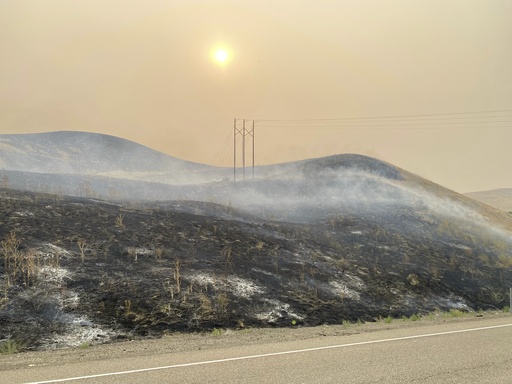BELLINGHAM, Wash. (AP) — Firefighters in the West are scrambling as wildfires threaten communities in Oregon, California and Washington, with at least one Oregon fire so large that it is creating its own weather.
Interstate 84 in eastern Oregon was closed in both directions Tuesday between Ontario and Baker City as flames from the Durkee fire advanced toward the roadway in multiple locations. The Oregon Department of Transportation also closed the eastbound lanes of I-84 from Pendleton to Baker City and warned Tuesday night that travelers should expect continued highway closures in eastern Oregon as fire crews actively fight fire from the interstate.
The Federal Emergency Management Agency on Monday night authorized the use of federal funds to help with firefighting costs for the lightning-caused blaze that started July 17. It had scorched nearly 375 square miles (971 square kilometers) as of Tuesday afternoon.
The Durkee fire was threatening homes in and around the communities of Durkee, Huntington and Rye Valley, as well as the interstate, cell towers and power infrastructure in the area. Fire crews and equipment from 22 states were battling the blaze as of Tuesday, authorities said.
Stephen Parker, a meteorologist with the National Weather Service in Boise, Idaho, said the Durkee fire showed such extreme fire behavior on Saturday, Sunday and Monday that it began creating its own weather system with a “pyrocumulus cloud.”
“That can happen when a fire becomes plume-dominated,” Parker said. “It’s like a thunderstorm on top of the fire, generated by the heat of the fire.”
The pyrocumulus cloud allows the smoke and ash from the fire to travel much higher in the air than it would typically go, he said. If there is enough moisture in the air above the fire, the pyrocumulus cloud can also generate rain and lightning, potentially causing new fire starts in the region.
There were lightning strikes in the region on Monday night, but there were also other thunderstorms in the area, making it impossible to tell which weather system was responsible for the storm, Parker said.
Tuesday morning was free of pyrocumulus clouds, Parker said, but they tend to form later in the day.
“I don’t see any pyrocumulus developing yet today. But I would not be surprised if we got a fourth day out of it,” he said.
Several new fires ignited in that area Monday because of severe weather that included lightning and strong wind gusts, the Baker County Sheriff’s Office said in a Facebook post.
“Within minutes of the first lightning strikes, reports then came in of visible flames,” the post read.
Multiple fires have scorched more than 1,093 square miles (2,830 square kilometers) in Oregon, with nearly 180 square miles (466 square kilometers) torched in the past 24 hours, authorities said.
Parts of the West have also been in the grip of a heat wave, including record-breaking triple-digits temperatures, for days.
A fire in the Columbia River Gorge that started late Monday forced urgent evacuations around the town of Mosier, Oregon, and the entire town of about 400 people was ordered to be ready to leave at a moment’s notice on Tuesday.
In central Washington, a fire that sparked Monday near Naches prompted mandatory evacuations while another near Bickelton also forced evacuations and threatened a natural gas plant. A fire that started Tuesday closed a section of U.S. 12 in both directions over White Pass.
“This is shaping up to be another monster fire year in the Pacific Northwest, and it’s just mid-July,” Ed Hiatt, Pacific Northwest Assistant Fire Director for Operations at the U.S. Forest Service, said Tuesday in a news release.
Millions of acres of national forest lands across Oregon and Washington are continuing to see record- breaking dry timber conditions on both sides of the Cascade Mountains with no “wetting” rains for more than six weeks in areas from far southern Oregon to the eastern part of the state and north into central Washington, according to the news release.
Oregon Gov. Tina Kotek earlier this month declared an “extended state of emergency” until October because of the increased risk of wildfires.
“I urge all Oregonians to follow the instructions and evacuation levels issued by emergency officials,” she said at the time, while also urging people to subscribe to emergency alerts, to have an evacuation plan, prepare a go-kit, and stay aware of changing conditions.
Near the California-Nevada border, a series of lightning-sparked wildfires in the Sierra forced the evacuation of a recreation area, closed a state highway and was threatening structures Tuesday in several communities southwest of Portola, which is about 50 miles (80 km) northwest of Reno.
Nearly 200 children and staff at a summer camp near Portola voluntarily evacuated on buses back to their homes Sunday night in the Reno-Sparks area.
Heat waves and historic drought tied to climate change have made wildfires more challenging to fight in the American West. Scientists have said climate change has made the region much warmer and drier in the past 30 years and will continue to make the weather more extreme, and wildfires more frequent and destructive.
___
Associated Press writers Rebecca Boone in Boise, Idaho, and Scott Sonner in Reno, Nevada, contributed to this story.
This website uses cookies so that we can provide you with the best user experience possible. Cookie information is stored in your browser and performs functions such as recognising you when you return to our website and helping our team to understand which sections of the website you find most interesting and useful.
